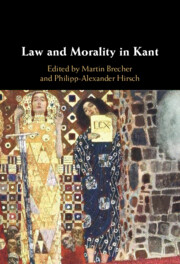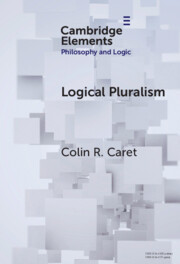Refine search
Actions for selected content:
134 results
Four - Marriage in the Flux of Self-Fashioning
-
- Book:
- Marriage and the Moral Imagination
- Published online:
- 12 December 2025
- Print publication:
- 22 January 2026, pp 119-143
-
- Chapter
- Export citation
Chapter 3 - Kant on the General Will Test and the Categorical Imperative Procedure
- from Part I - Law and Morality: Derivation or Separation?
-
-
- Book:
- Law and Morality in Kant
- Published online:
- 16 December 2025
- Print publication:
- 22 January 2026, pp 54-74
-
- Chapter
-
- You have access
- Open access
- HTML
- Export citation
Chapter 4 - Kant’s Right as Normatively Independent
- from Part I - Law and Morality: Derivation or Separation?
-
-
- Book:
- Law and Morality in Kant
- Published online:
- 16 December 2025
- Print publication:
- 22 January 2026, pp 75-92
-
- Chapter
-
- You have access
- Open access
- HTML
- Export citation

Law and Morality in Kant
-
- Published online:
- 16 December 2025
- Print publication:
- 22 January 2026
-
- Book
-
- You have access
- Open access
- Export citation
Precious Goods
-
- Journal:
- Utilitas , First View
- Published online by Cambridge University Press:
- 09 December 2025, pp. 1-15
-
- Article
-
- You have access
- Open access
- HTML
- Export citation
Confronting stasis and navigating pathways of change in green finance: Researcher agencies, emotions, and normativities
-
- Journal:
- Finance and Society / Volume 11 / Issue 3 / December 2025
- Published online by Cambridge University Press:
- 13 November 2025, pp. 460-472
-
- Article
-
- You have access
- Open access
- HTML
- Export citation
Chapter 3 - Hegel’s Critique of Liberalism
- from Part I - Hegel, Freedom and Liberalism
-
- Book:
- Hegel Beyond Liberalism
- Published online:
- 27 September 2025
- Print publication:
- 16 October 2025, pp 61-86
-
- Chapter
- Export citation
Chapter 2 - The Dialectic of Freedom
- from Part I - Hegel, Freedom and Liberalism
-
- Book:
- Hegel Beyond Liberalism
- Published online:
- 27 September 2025
- Print publication:
- 16 October 2025, pp 37-60
-
- Chapter
- Export citation

Logical Pluralism
-
- Published online:
- 30 September 2025
- Print publication:
- 23 October 2025
-
- Element
- Export citation
Normativity and the Good: Aquinas and Two Contemporaries on the Logic and Metaphysics of Normative Claims
-
- Journal:
- New Blackfriars ,
- Published online by Cambridge University Press:
- 15 September 2025, pp. 1-16
-
- Article
- Export citation
Normative rationality after behavioral economics: what is left?
-
- Journal:
- Behavioural Public Policy , First View
- Published online by Cambridge University Press:
- 08 September 2025, pp. 1-10
-
- Article
-
- You have access
- Open access
- HTML
- Export citation
5 - (De)Constructing the Invisible Interface
- from III - Producing Little Texts
-
- Book:
- The Cultural Politics of Digital User Experience Writing
- Published online:
- 24 July 2025
- Print publication:
- 07 August 2025, pp 111-138
-
- Chapter
- Export citation
Chapter 2 - The Many Ends of Natural Law
-
-
- Book:
- Kant's Lectures on Political Philosophy
- Published online:
- 18 July 2025
- Print publication:
- 07 August 2025, pp 28-47
-
- Chapter
- Export citation
On Being Ignorant
-
- Journal:
- Canadian Journal of Philosophy / Volume 54 / Issue 5 / July 2024
- Published online by Cambridge University Press:
- 03 June 2025, pp. 346-363
-
- Article
-
- You have access
- Open access
- HTML
- Export citation
6 - A Terrible Experience!!! vs. A Terrible Experience
- from II - Persuasion and (New) Contexts of Use
-
-
- Book:
- Manipulation, Influence and Deception
- Published online:
- 10 June 2025
- Print publication:
- 24 April 2025, pp 107-134
-
- Chapter
- Export citation
Normativity in practice: Ordering through enactment, learning, and contestation in global protests
-
- Journal:
- Review of International Studies / Volume 51 / Issue 5 / September 2025
- Published online by Cambridge University Press:
- 10 April 2025, pp. 800-819
- Print publication:
- September 2025
-
- Article
-
- You have access
- Open access
- HTML
- Export citation
IS CODE DESTINED TO SUPERSEDE LAW? BEHAVIOURAL CONTROL BY CODE AND LEGAL THEORY
-
- Journal:
- The Cambridge Law Journal / Volume 84 / Issue 1 / March 2025
- Published online by Cambridge University Press:
- 06 March 2025, pp. 175-208
- Print publication:
- March 2025
-
- Article
-
- You have access
- Open access
- HTML
- Export citation
2 - Principles of Cognitive CDA
-
- Book:
- Language, Image, Gesture
- Published online:
- 08 January 2025
- Print publication:
- 13 February 2025, pp 28-47
-
- Chapter
- Export citation
4 - Trilogues
-
- Book:
- Trilogues
- Published online:
- 09 January 2025
- Print publication:
- 23 January 2025, pp 103-139
-
- Chapter
- Export citation
Should we respond correctly to our reasons?
-
- Journal:
- Episteme , First View
- Published online by Cambridge University Press:
- 21 January 2025, pp. 1-22
-
- Article
-
- You have access
- Open access
- HTML
- Export citation
